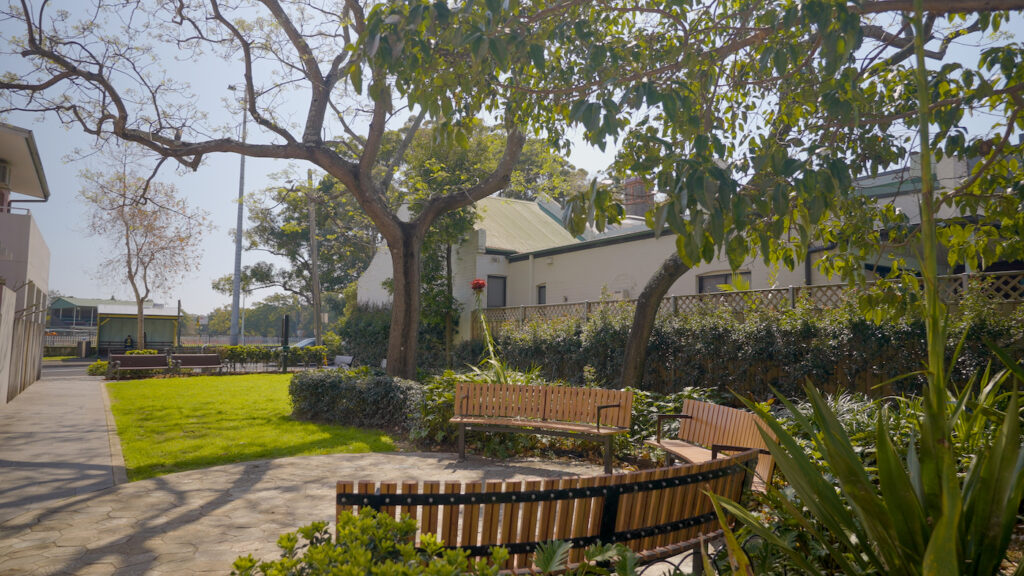Tiny pocket parks make a big impact on urban living according to UNSW Sydney – These miniature-sized parks could help insert more public recreational spaces into our cities.

In growing cities, where we need to squeeze the most out of every parcel of land, where do we find the space for new parks and other outdoor recreational areas?
Some inner-city councils are turning to pocket parks. These miniature versions of parks can look like their larger counterparts – some seating, plants, and shade for passers-by to relax – but they’re noticeably tiny in scale, typically no bigger than a few hundred square meters. But don’t let their small size fool you – they’re more than just a gimmick.
Dr Mike Harris, Senior Lecturer in urban design and landscape architecture from the School of Built Environment at UNSW Arts, Design & Architecture, says despite their small stature, pocket parks dramatically enhance the quality of life for the communities around them.
“One of the issues from an urban liveability perspective is that with increasing population density, we need more public space,” Dr Harris says, “These pocket parks are a terrific opportunity to answer that problem and to provide public space for the local community where previously there may not have been any.”
Making public space more accessible
Pocket parks often pop up in dense urban areas where space for larger public parks is both costly and limited. In Sydney, many already exist around the inner west, and more are under construction in the eastern suburbs, where smaller public spaces weren’t historically considered in planning regulations.
“The city has big public gestures like Centennial Park, but it wasn’t master planned to have many smaller parks in its subdivisions,” says Ela Glogowska, architect and PhD candidate at the School of Built Environment researching the history of public space in Sydney. “So, it’s no surprise that today we have a massive deficit of accessible public socialising areas.”
Most pocket parks are created opportunistically by repurposing underutilised land without undertaking large-scale redevelopment. In some cases, local governments may purchase an existing lot of land, usually dilapidated or unsuitable for commercial development, to replace it with a park. But the simpler way is to reclaim a portion of the street.
“The idea behind pocket parks is to get more out of the space we have in cities, and the ideal place in the existing public domain is our street network,” Dr Harris says. “Usually, that’s a closure to cars and converting a small portion of the street into a useable recreational space that the whole community can enjoy.”
Unlike one large-scale park, several smaller pocket parks can be inserted strategically throughout a neighbourhood to help increase accessibility and usage of public space.
“The amount of public space is essential, and we do still need our large public commons, but distribution and proximity are just as important,“ Dr Harris says. “Having more of these smaller pocket parks can make accessing public space more incidental and a part of daily life, rather than an event you must plan for and go out of your way to access.”
“Having more open and accessible public spaces for residents plays an essential role in building a sense of community,” Ms Glogowska says. “These are the places where people bond, interact and enjoy life, which is why we want to live in cities in the first place.”
Pocket parks also benefit the environment by introducing more greenery and tree cover, which may be difficult to find in urban areas.
“Our urban areas are getting hotter, and we know one of the ways we can mitigate against that is through trees that have a cooling effect,” Dr Harris says. “Pocket parks can help us find additional space to develop and expand the canopy cover for our cities.”
The parks themselves can also be tailored to the local community’s needs. For example, a pocket park in a town centre might be more like a plaza with some tables and seating for workers, while a more residential type might have some play equipment for children.
“They’re a fantastic opportunity for council to deliver a community asset, cost-effectively and with minimal disruption, and listen and respond to the needs of the local population through design,” Dr Harris says. “If we want to start to improve the quality of our public domain, anything we can do to prioritise people more helps to do that.”
While pocket parks alone may not be the silver bullet for liveability, more public space for the community is beneficial, even on a small scale.
“We must consider public spaces as social infrastructure and value them in terms of their wellbeing benefits,” Ms Glogowska says.
“If we want a healthy and happy society, we need a diversity of quality public spaces for the public to enjoy, and more pocket parks will certainly contribute to that.”


